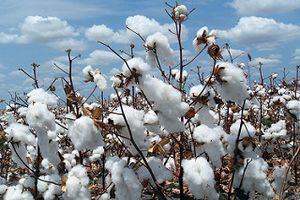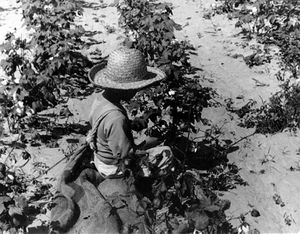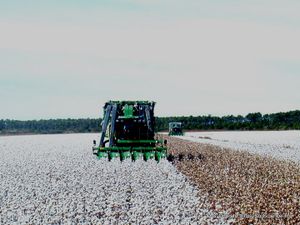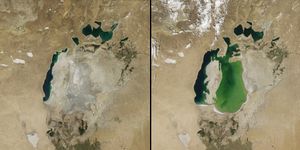Course:CONS200/2016w2/Wiki Projects/Social Costs
| This conservation resource was created by Course:CONS200. |
Ecological and Social Costs of Cotton Farming

In today’s age, cotton is one of the most versatile crops that the earth has to offer. Many of us are familiar with the usage of clothing in cotton, but cotton is also used in beauty products and food products as well. Look at the clothes that you are wearing right now, a majority; if not all of it is made out of cotton material. Cotton is favorable in clothing because of its softness, durability, and insulation characteristics.[1] The leftover cotton seed can be used to make cottonseed oil and cotton meal. The oil can be used in cooking, such as deep frying foods or used in salads as a dressing. If not used in cooking, cottonseed oil can also be used to make tons of oil-based products such as soap, candles, or even cosmetics. Cotton meal is rich in protein and is used for human consumption or for animal fodder.[2] These cotton products and byproducts are used by people all around the world, the amount of cotton consumed must be insane! The growth of cotton takes up approximately 2.5 percent of the world's cultivatable land across 85 different countries.[3] During the year of 2015 to 2016, the world consumed a staggering amount of 24.2 million metric tons of cotton.[4] This includes uses of cotton in all its forms. However, with the good comes the bad and although cotton has a ton of benefits, it also carries many social and environmental drawbacks.
History

In today’s age, cotton is one of the most versatile crops that the earth has to offer. It has a wide range of use from cooking to clothing. Clothing is one of the most common uses of cotton, and this can be traced back over 5000 years ago.[5] Cotton was discovered in various locations such as Mexico, India, and Egypt.[5] From there, traders from India brought their knowledge of cotton to other countries such as Europe and Asia. Slowly, cotton began to grow in popularity as countries saw how durable and versatile it was. As more and more countries began to utilize cotton, the methods of transforming cotton into usable material became increasingly advanced which allowed the global production of cotton to grow exponentially. However, these offshore cotton products threatened the local British manufacturers, so the government implemented the Calico act in 1721 to counteract the invasion of cotton products.[6] This act outright banned the sale of any cotton product.[6] Thankfully, the act was repealed in 1774 as technological advances made it economically viable for Britain to start producing their own cotton products.[7] During the 17th century, Britain was one of the powerhouses in the cotton industry. Finding success with the poorer class of people, cotton quickly became one of the most traded goods for Britain because it was cheaper than other materials available such as silk. Cotton made up a majority of Britain’s exports during the late 1700’s and early 1800’s. By the 18th century, the industrial revolution would make it even easier to produce mass quantities of cotton. Cotton mills began to open up in Europe and North America with resources such as child labor and slavery, mill owners were able to rack in huge profit by making the workers work long hours and paying them with low wages.[8] As the global demand for cotton grew higher in the tail ends of the 18th century, Capitalists began to look to expand and place mills on other locations. One of the prime locations was the United States, with plenty of free land and resources. These new mills particularly flourished in states that allowed slavery, such as Georgia, Alabama, and Mississippi. Fast forward to the 21st century, and cotton has taken over the industry.[9]
Cotton Farming Methods
As a kind of important cash crops to most countries, cotton farming has had a history of more than five thousand years. Due to its complicated process of producing and spinning, cotton was not the prime fibers in the first place and people had no machine but have to do all the work by their hands. In the 17th century, the industrial revolution and the invention of the cotton gin in the U.S. played very crucial roles of cotton production, and therefore, because of technical innovation, cotton has occupied approximate 48 percent of textile production in the world.[10]
To plant good variety of cotton, the following conditions should be considered.
1.Climate and Soil
Cotton has preference of living between 46 ° north and 36° south on the continent of subtropical and tropical areas [10] with the mean temperature of 16 ℃ for germination, 23 ℃ for vegetative growth, and 29 ℃ during fruiting period.
In addition, they need the minimum precipitation of at least 50 cm annually if they are not planted on river catchments. Climate should be fairly dry and have enough sunshine when growing. [11]
As to soil, fertile soils containing sand and clay with a good nutrient content are the best to cotton, which are mainly near valleys and rivers. Black soils and red sand loam are some of the good examples. Cotton growing under these conditions have better advantages of increasing production. [11]
2. Land preparation and planting
In some areas that cotton is annual instead of perennial, farmers need to cut the rods of cotton from previous year and bury them under the ground before planting. Then use mechanical planter for seedbed preparation. In general, plantation starts from early March in the southernmost of America but Northern people need to wait until May. [12]
3. Nurture
Most of the cotton is not required to be planted as the method of thinning. Weeds are mechanically removed from the seedlings, and chemicals are also used to stop the growth of weeds. [12]
4.Pests and Diseases
Cotton is susceptible to many insects, including cotton bollworms, cotton borers, red spiders (cotton spider mites), and cotton aphids. Therefore, not only spraying cotton insecticide, but also strict quarantine to prevent the spread of cotton bollworm are necessary. For instance, cotton aphids can be controlled by spraying Malathion 0.08%.[11]
Cotton fungal and bacterial diseases include root rot, fusarium wilt, and bacterial blight. These diseases can be prevented by crop rotation, the use of fertilizers, and dealing soil and seeds with chemicals.[11]

5.Cotton harvest
Cotton takes approximate 200 days to mature. Although most of the cotton is picked by machines, some is also picked manually. The most common method of manual picking is removal of villi from cracked cotton bolls. Since not all of the bolls are ripe at the same time, the pickers must walk back and forth in the field for two or three times. Another method of manual picking is called snapping, which is that the whole boll is picked off directly. Snapping is much faster than the traditional way, but this method only works to some specific types. [13]
After the World War two, the use of mechanical harvesters increased significantly in the U.S. The Spindle-type cotton harvester uses a vertical cylinder with a rotating spindle to pull the cotton out of the cracked bollard. This type of harvester barely causes harm to the cotton and cotton bolls that have not cracked. One Spindle-type cotton harvester can complete the workload of 30 to 40 picking workers. [14]
Issues With Modern Methods
The use of pesticides leads to severe damage not only to lands, rivers, lakes and oceans, but also to biodiversity in the natural areas. The water that contains pesticide residues, salts and fertilizers might run-off from the irrigation plots to adjacent areas because of improper methods of farming and irrigation. [15] As everybody knows, pesticides contribute to prevention of diseases and pests to cotton, but on the other hand, those are made up of chemical substances which are toxic to wildlife. Soil salinization is another serious issue. In some dry places, too much water irrigated then evaporated too fast causes soil salinization and furthermore, decreases soil fertility. [15] [16]
Although the cultivated area of cotton only takes up 2.5 % of total agricultural area, 16% of insecticides in the world and 6.8% of herbicides are consumed here. [15] Therefore, disturbance in ecosystem occurs and then reduces the biodiversity in this area. Some pests might be eliminated by the pesticides, but their natural enemies could be wiped out as well. [16]
Costs of Cotton Farming
Environmental Costs
The production of cotton has spread to a global level, but current cotton production methods are still environmentally unsustainable ultimately placing large environmental burdens upon the industry. The cost of growing cotton is still very inefficient costing 20,000 liters of water to produce one kilogram of cotton. Some experts argue that cotton is the largest user of water agricultural products, causing large amount of freshwater loss through inefficient water management and evaporation through irrigation of the fields. [17] Also when cotton is cultivated intensively, a large amount of water is used for irrigation causing soil salinization causing degradation of soil fertility particularly in dry areas. Cotton being a very pesticide-intensive crop requires the application of a substantial amount of pesticides and fertilizers, accounting for 6.8% of the world’s herbicides usage and 16% of all insecticides used worldwide. Due to this cotton production plays a role in climate change through the use of industrial fertilizers, excessive amounts of nitrates introduced to the land leads to the creation of nitrous oxides, a greenhouse gas that is far more harmful than carbon dioxide by 300 times in terms of global warming. [16]
Furthermore due to agricultural methods and irrigation systems runoff of pesticides, fertilizers and minerals contaminate rivers, wetlands, lakes and other water sources. Polluting water sources with toxins and chemical substances that greatly affect the biodiversity of wildlife through direct contact and long term accumulation within the biosphere, soil and freshwaters. [17]
Honeybees and wild bees being the essential pollinators of plants, greatly support the foundation of crop production throughout the world. But however due to cotton's constant requirement for pesticides, honeybees and wild bees are affected negatively as a result. It is estimated that approximately 20% of honeybee colonies are negatively affected, 5% of colonies killed and 15% severely weakened by the pesticides within the US. It has furthermore been demonstrated that various cotton varieties have a production increase from 20% to 30% due to the support of honeybee pollination. Annual crop lose due to pollination losses from wild bees affected by pesticides is estimated to be about 10% of pollinated crops resulting in a reduced yield of $210 million a year. [18]
Social Costs
Being one of the most profitable non-food crop across the world. Cotton generates income worldwide for more than 250 million people and employing almost 7% of all labor in developing countries. [17] Many cotton farmers depend on the sales of cotton to middle men or ginners below the production cost in order to survive while living below the poverty line. Due to this most cotton farmers in developing countries such as West Africa are only able to make minimal income for basic essentials like healthcare, food, school fees and tools. Furthermore fluctuations in production cost, climate, production yield and market prices of cotton place farmers in a challenging position to provide decent wages and conditions for workers. Often because of the high cost of inputs needed, such as pesticides and fertilizers many farmers like those in India are seriously indebted due to the high interest loans needed to purchase the essentials for cotton farming. With low returns farmers often make less than the cost of inputs, making little beneficial change to their financial situation. [19] The use of pesticides and chemical fertilizers furthermore cause soil degradation making soil conditions poor decreasing cotton yields to decrease. Also due to lack of adequate equipment and knowledge many small farmers are negatively affected when pesticides are used leaving many ill or dead. [16]
Many health problems are apparent after the use of pesticides such as acute poisonings, cancer and other chronic effects. Worldwide, there are more than 26 million cases of non-fatal pesticide poisoning with about 3 million hospitalized cases, roughly 220,000 fatalities and another 750,000 chronic illnesses per year. Furthermore sufficient evidence is present showing major chronic health effects linked to the use of pesticides such as cancer, respiratory, neurological and reproductive effects. Further evidence has shown that pesticides can cause sensory disturbance and cognitive effects such as learning impairment, memory loss and language problems. [18]
Layering Perspectives: Additional Cost and/or Implications?
The description above details the costs and implications from cotton farming from the perspective of a natural resources conservation student. In this section, we welcome contributions from other perspectives. Those interested in contributing to this case study may use the following questions as a guide:
- What other costs and/or implications become apparent when cotton farming is viewed through the lens of other disciplines and professions?
- What special expertise, resources, or theoretical orientations might others bring to help us better understand the costs and/or implications associated with cotton farming?
Real World Examples
The social and ecological aspect of cotton farming are linked to one another. Social problems of farmers arise due to the economic instability of the cotton farming industry while having large ecological pressures.
Debt in India
A prominent example of a social problem takes place in India where nearly 90% of rural Indian farming households are in debt as of early 2017.[20] In years 2013 and 2014, there was a surge in global cotton demand producing record harvest numbers as high as 40 million bales which eventually pushed down cotton prices and raised production costs.[21] The increase in pesticide, fertilizer, and seed prices along with the decrease in the price of cotton eventually create a negative net income creating debt to farmers across the country.[21] Unseasonal weather events such as rain and hail due to climate change destroy a large volume of crops and roads for transport each year, increasing transport costs and further decreasing the annual potential yield.[21] [22] Commercial cotton companies also fail to meet payment dates, inconveniencing farmers to continuously use income from cotton companies to repay offset loans which were caused by the same cotton companies to begin with. [22] Indian cotton farmers eventually lose their farm property and commit acts of suicide.[20] A survey conducted in 2010 recorded that of 7,000 farmer suicides, more than 4,500 (equates to approximately 65%) are victims of suicide due to debt related purposes.[20]
Diminishing of Aral Sea

A prominent socio-ecological example of the severity of cotton farming is the diminishing of the Aral Sea. In the 1960’s, Soviet engineers built irrigation networks which consisted of several thousand miles of canals, dams, and reservoirs to redirect streams that fed the Aral Sea to irrigate cotton and wheat in Kazakhstan and Uzbekistan.[23] Over several decades, the lake began to recede in depth eventually revealing the bottom of the lake. What a shrinking lake means is that salinity levels start to increase as salt levels increase due to evaporation, pesticides, and crop-killing salts accompany a smaller volume of water.[24] Several species of fish which died in millions have also gone extinct because of high salinity levels and low water volume. These problems cause difficulty for local communities who once reside close to the lake as the local fishing industry is destroyed by the diminishing fish populations and dust storms forming much more often by low moisture levels.[23] This proves that the Aral Sea, being more than just a climate issue is also an extinction issue. On the other hand, modern players of the cotton industry, such as the fashion industry demanding high volumes of an irrigation intensive crop lead to irreversible levels of species and environmental destruction.[25] Much of the cotton farmed in Uzbekistan is hand-picked using forced labour.[26] The Uzbekistan Government officials also order employees which ranges from doctors to students, and even children as young as nine years old which is considered morally wrong and illegal since 2012 but disregarded.[26] Having both the destruction of the environment and forced labour being linked is a severe issue that needs reevaluation by the cotton industry.
Active Solutions
As cotton is becoming a less popular crop to cultivate, there have been many attempts to revive cotton farming by means such as government support, mechanization, genetic modification, and farming alternative cotton species.
Kenya's Solution
Countries such as Kenya have begun working together with their cotton farmers to better growing conditions and increase annual yield to meet global demands through mechanization and more efficient irrigation projects which utilizes more on rainfall.[27] Mechanization allows larger amounts of cotton can be harvested which improves partnerships between local and international businesses as well as improving quality of life for farmers.[28] Kenya considers crop an important method of employment creation. By increasing annual yield, large amounts of jobs can be created in a chain ranging from cotton production, to spinning and weaving, to the finished product[29]. These improvements are set to be held by shifting farming and production policies to further benefit locals with more work and increase transparency in pricing to prevent exploitation of farm workers.[29] Taking different varieties of cotton from other countries, three new genetically modified varieties of cotton seeds are being tested, and having two approved as of March 2017 by the ministry of Kenya.[27] [28] [29] This helps farmers maintain a stable crop yield, increase cotton quality, and resist termites and weeds without the use of herbicides and pesticides. [28] [29] The Kenyan government is also enhancing relationships with researchers to maintain and increase cotton quality control.[27]
Layering Perspectives: Alternative Solutions?
In this section we welcome contributions from scholars and students to widen the scope of possible solutions in addressing the implications associated with cotton farming. Those interested in contributing to this case study may use the following questions as a guide:
- Viewed through the lens of other disciplines and professions, what other actors become relevant when considering solutions to address challenges associated with cotton farming?
- What special expertise, resources, or theoretical orientations might others bring to help us better resolve challenges associated with cotton farming?
Conclusion
Although cotton is so commonly used today, the price which we pay will have disastrous effects on the global ecosystem over the long term. In order to grow cotton, many conditions have to be met and lots of resources must be used. In order to produce one kilogram of cotton, over 20,000 liters of water must be used to water the plants.[17] Additionally, because cotton is vulnerable to many plants and diseases, the plants must be sprayed with chemicals and insecticides to make sure the plant comes to fruition. These sprays pollute the ecosystem and the wildlife around it which lowers the quality of wildlife around the area. Combined with the large amounts of water used to keep the plants alive and maintained, the contaminated water leaks into the ecosystem and harms it greatly. Since cotton takes approximately 200 days to mature[13], contaminated water is continuous being poured into these ecosystems. Once these plants are ready to be harvested, special machines must be used to harvest the cotton efficiently. This further contributes to the negative ecological disturbances from this growing process. Along with the abiotic effects, there are also biotic effects. Cotton is the main income source for over 250 million people[17], and when the price of cotton fluctuates, the farmers feel every up and down. Farmers in third world countries especially feel this burden as the income they make barely covers their living expenses. These farmers must also factor in the immense startup and maintenance costs to produce the cotton, which is not guaranteed to sell at the right price. Many times without sufficient equipment, farmers resort to using themselves to make sure the cotton plants are growing. In the midst of insecticides and other chemicals, farmers health quickly come into question.
However, countries are beginning to recognize the consequences of growing cotton and they are actively trying to find a solution. In Kenya, the government has begun to work with its cotton farmers to make sure they are able to farm safely and effectively. Providing farmers with better equipment and developing genetically different cotton to be more resistant to the environment are some ways that the government is helping the farmers.[27] [28] [29] Through this relationship, Kenya hopes that the cotton yield will be higher and will be able to create more jobs for the locals.
References
- ↑ Gupta, Sanjana (January 12, 2015) The Pros and Cons of Cotton Clothing
- ↑ Cotton Australia (2016)Properties and Cotton Products
- ↑ Howell, Stacey (July 21, 2015) How Much of the World's Clothing Is Made From Cotton?
- ↑ Cotton Incorporated (2017)World Cotton Consumption and Import
- ↑ 5.0 5.1 Cotton Australia The History of Cotton
- ↑ 6.0 6.1 Fisher, Peter (2012)The Calico Acts: Why Britain Turned its Back on Cotton
- ↑ Magdoff, Webster, and Nowell (January 13, 2000)Colonialism, Western
- ↑ Trueman, C.N. (2016) The Cotton Industry and the Industrial Revolution
- ↑ Oyangen, Knut The Cotton Economy of The Old South
- ↑ 10.0 10.1 WWF Global Agriculture problems - Cotton
- ↑ 11.0 11.1 11.2 11.3 MRC SEEDS Cotton Production
- ↑ 12.0 12.1 How Products are Made Cotton
- ↑ 13.0 13.1 organic cotton Harvest and post-harvest quality management
- ↑ COTTON COUNTS The story of cotton
- ↑ 15.0 15.1 15.2 WWF Global The impact of cotton on freshwater resources and ecosystems
- ↑ 16.0 16.1 16.2 16.3 organic cotton The risks of cotton farming
- ↑ 17.0 17.1 17.2 17.3 17.4 WWF- Cotton.
- ↑ 18.0 18.1 Pimental, David (March 6, 2004) Environmental and Economic costs of the application of pesticides primarily in the United States
- ↑ Parry, Martine (June 11, 2015) The Role of Cotton in Economic and Social Developement.
- ↑ 20.0 20.1 20.2 Ruchika M Kanna (March 6, 2017) 80% of farm suicides by cotton growers: Study
- ↑ 21.0 21.1 21.2 Pokharel, Sugam (April 20, 2015) Why India's cotton farmers are killing themselves
- ↑ 22.0 22.1 Dzenga, Leroy (March 20, 2017) Cotton farmers grieve over disillusioned market price
- ↑ 23.0 23.1 Howard, Brian C. (October 2, 2014) Aral Sea’s Eastern Basin Is Dry For the First Time in 600 Years
- ↑ Morton, Ella (May 2, 2014) Aridity and Anthrax: The Disastrous Effects of a Shrinking Sea
- ↑ Hoskins, Tansy (October 1, 2014) Cotton production linked to images of the dried up Aral Sea Basin
- ↑ 26.0 26.1 The Economist (October 16, 2013) Forced labour in Uzbekistan In the land of cotton
- ↑ 27.0 27.1 27.2 27.3 Kipkemoi, Hillary (March 9, 2017) Subsidies, training and partnerships will revive cotton farming, says Bett
- ↑ 28.0 28.1 28.2 28.3 Fibre2Fashion (March 10, 2017) Kenya to revive cotton farming with mechanisations
- ↑ 29.0 29.1 29.2 29.3 29.4 Alushula, Patrick (March 9, 2017) Kenya eyes past glory with cotton farming reforms
